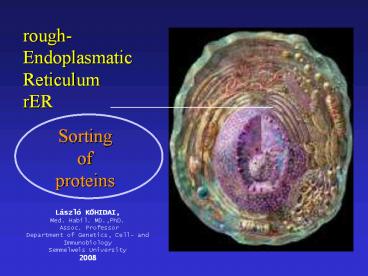rough-Endoplasmatic%20Reticulum%20rER PowerPoint PPT Presentation
Title: rough-Endoplasmatic%20Reticulum%20rER
1
rough-Endoplasmatic ReticulumrER
2
- Endoplasmic inside the cell reticulum
network - Extensive membrane system
- Includes up to half of membrane of cell
- Tubules and sacs cisternae
- Continous with the nuclear envelope
- Two types rough ER (ribosomes)
- smooth ER
3
rER
4
s-ER (smooth ER)
- Structure tubular
- Function
- synthesis of phospholipids, cholesterol,
- ceramide
- synthesis of steroids
- storage and regulation of Ca2
- detoxification cyt P450
5
TEM of ribosomes attached to the rER in a
pancreatic exocrine cell
6
mRNA
peptide
polyribosome
7
Ribosomes mRNA Polyribosome
8
Molecular composition of ribosome
rRNA
60S rRNA peptides
9
Ribosome subunits
10
(No Transcript)
11
Comparison of prokaryotic and eukaryotic ribosomes
12
Structure of ribosome
?
13
t-RNA
activator enzyme of AA
ribosome
anticodon
codon
14
Identity elements of tRNA
15
Initiation
16
Elongation
17
(No Transcript)
18
(No Transcript)
19
(No Transcript)
20
Peptide bond formation
peptide bond
peptidyl transferase
21
Tunnel formation in ribosomal complex
22
Tunnel formation in ribosomal complex
23
Termination
24
Internalization of peptides into the rER
25
(No Transcript)
26
Synthesis of secretory proteins on the rER
27
Structure of SRP
- Universal
- 300 base RNA
- Six proteins
- P54 - signal peptide
- P9, P14 - ribosome
- P68, P72 move the
- peptide
28
Synthesis of secretory proteins on the rER
29
(No Transcript)
30
Electron microscopic view of a translocon channel
31
The ribosome-translocon-ER membrane complex
32
Translocon complex
- TRAM ( translocating chain-associated
membrane - protein) binds the signal sequence
- Sec61p major constituent of the translocon
channel - assembles into a donut-like structure
- Sec 61 b and Sec 61g bind to Sec 61p to form the
Sec 61 - complex
- The Sec 61 complex binds the ribosome,
- participates the transmembrane transfer
33
Cycles of GDP/GTDP exchange and GTP hydrolysis
that drive insertion of nascent secretory protein
into the translocon
34
Topologies of some integral membrane proteins
synthesized on the rER
35
(No Transcript)
36
(No Transcript)
37
Synthesis and insertion into the ER membrane of
the insulin receptor and similar proteins
- N-terminus faces to ER lumen
- C-terminus faces to cytosol
- A signal sequence is cleaved
- Stop-transfer membrane-anchor
- signal
38
Synthesis and insertion into the ER membrane of
the asialoglycoprotein receptor and similar
proteins
39
Synthesis and insertion into the ER membrane of
proteins with multiple transmembrane a-helical
segments
- An uncleaved internal signal membrane-anchor
sequence - A stop-transfer membrane-anchor
sequence - An uncleaved internal signal
membrane-anchor sequence Etc.
40
SRP cycle
41
Post-translational modification
- Proteolytic cleavage of proteins
- Glycosilation
- Acylation
- Methylation
- Phosphorylation
- Sulfation
- Prenylation
- Vitamin C-dependent modifications
- Vitamin K-dependent modifications
- Selenoproteins
42
(No Transcript)
43
(No Transcript)
44
Proteolytic cleavage
- Removal of signal peptide from
- preproproteins
- preproteins
- Signal peptidase
45
Properties of uptake-targeting signal sequences
Target organelle Usual signal location within protein Signal removal Nature of signal
rER N-terminal core of 6-12 mostly hydrophobic amino acids, often proceeded by one or more basic amino acids
Mitochondrium N-terminal 3-5 nonconsecutive Arg or Lys residues often with Ser and Thr no Glu or Asp
Chloroplast N-terminal No common motives, generally rich in Ser,Thr, poor in Glu and Asp
Perixisome C-terminal - Ser-Lys-Leu
Nucleus Internal - Cluster of 5 basic amino acids or two samller clusters separated by 10 amino acids
46
Glycoproteins
Predominant sugars are glucose, galactose,
mannose, fucose, GalNAc, GlcNAc,
NANA O-glycosidic linkage hydroxyl group of
Ser, Thr, hydrLys N-glycosidic linkage
consensus sequence N-X-S(T) (BUT No P) Major
N-linked families high mannose type, hybride
type, complex type (sialic acids)
47
Glycosilation
rER N-linkage to GlcNAc
rER O-linkage to GalNAc
48
O-linked sugars sugars coupled to UDP, GDP
(mannose), CMP (NANA) glycosprotein
glycosylttransferase N-linked sugars Requires a
lipid intermediate dolichol phosphate
49
N-Glycosilation
50
(No Transcript)
51
Glycosylphosphatodyl inositol (GPI) -anchored
peptides
GPI-anchored peptides become the outer surface
of the surface membrane
52
Protein folding Protein Disulfide Isomerase (PDI)
- Provides mechanism
- for breaking incorrectly
- paired disulfide bonds.
- The most stable folded
- sate is reached
53
Protein folding Bip
- Bip binding protein Hsc70
- Member of Hsp-70 family of chaperones
- Located in the ER lumen
- Binds reversibly to the translocon
Roles - promotes correct folding of
nascent peptides (Bip-ATP Bip-ADP) -
required for translocation through the
translocon - prevents aggregation or proceeding
of misfolded proteins - sealing the
luminal end of the translocon pore
54
Protein folding
- Peptidyl-prolyl isomerase
- accelerates rotation about peptidyl-prolyl bonds
- Oligosaccharidem protein transferase
- transfers carbohydrate chains to the nascent
- polypeptide as they enter the lumen of ER
- Calnexin, calreticulin
- interact with CHO groups of glycoproteins
55
Protein signals
- Integral, soluble proteins of ER, Golgi
retrieved by - the KDEL-receptors. They recognize the KDEL
signal - (Lys-Asp-Glu-Leu at C-terminus).
- ER membrane proteins have a KKXX (dilysine
motif) - on the C-terminus.
- Other ER membrane proteins possess di-arginine
motif - on the N-terminus.
56
Chase-pulse technique
57
Antibiotics
- They inhibit different steps of protein synthesis
- Actinomycin D - transcription (complex with
DNA) - Rifamycin - transcription (RNA polymerase)
- Amanitin - transcription (RNA polymerase II)
- Streptomycin - iniciation
- Tetracycline - aminoacyl-tRNA - A locus
interaction - Erythromycin - translocation of tRNA from A to
P locus - Cycloheximide - (only in
eukaryotes) - Chloramphenicol - peptide bond formation
- Puromycin - termination
- Penicillins and Cephalosporins - synthesis of
bacterial cell wall - (proteoglycans)
58
actinomycin rifamycin amanitin
streptomycin
chloramphenicol
tetracycline
erythromycin, cycloheximide
puromycin

